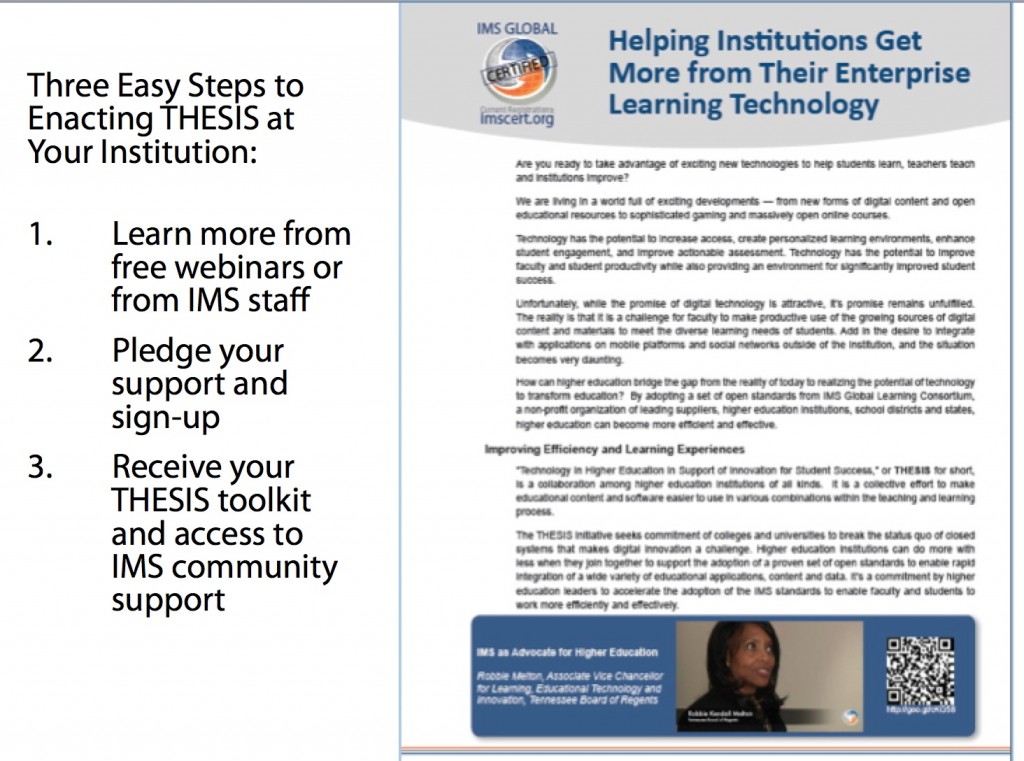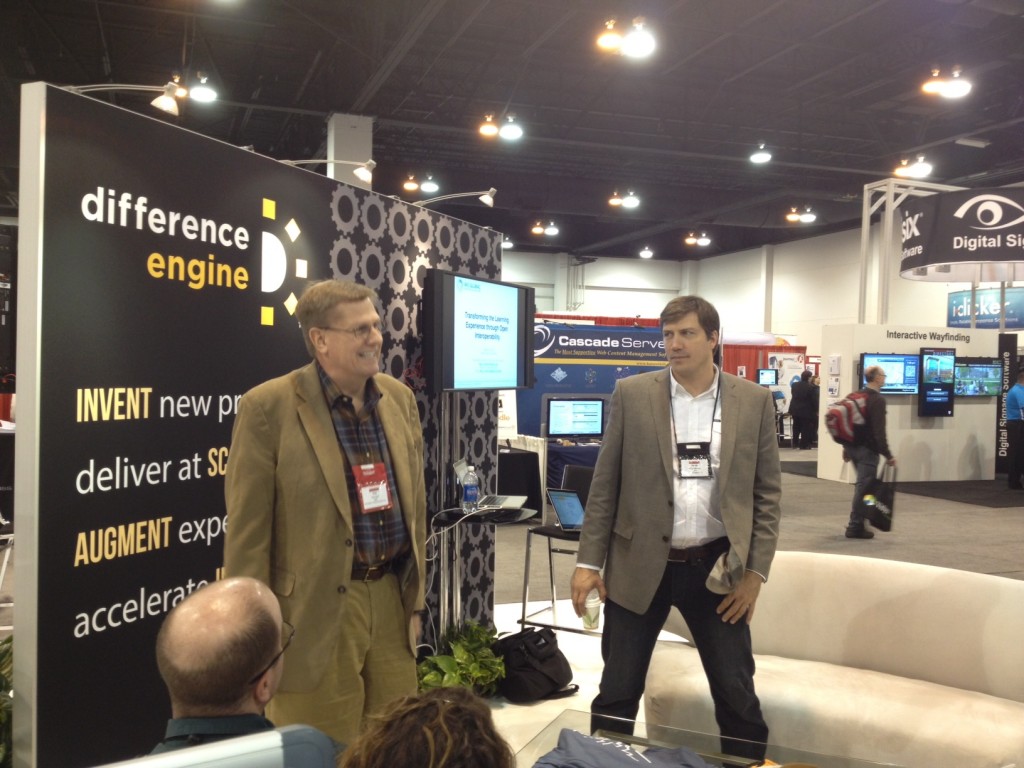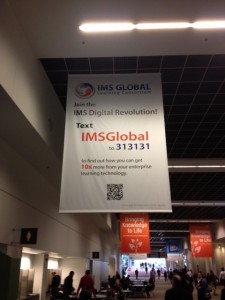We’re talking about the 1EdTech Open Digital Innovation Revolution in Education this week at EDUCAUSE 2012 Denver.
Here’s what it is all about:
After several years of 1EdTech community effort (led by the 1EdTech Contributing Member organizations), we are now seeing evidence of a 10-100x improvement in the cost and time of digital technology and content integration based on the 1EdTech standards, collectively known as the Digital Learning Services Standards (Common Cartridge, Learning Tools Interoperability and Learning Information Services).
So, at EDUCAUSE this year, we are shifting our communication focus a bit toward institutional tech leaders (CIOs, academic technology, online learning leaders). Why? So they can take full advantage of the revolution and engage in sustaining the open digital revolution and taking it even further! See the 1EdTech agenda at EDUCAUSE 2012 here. (Note: There will be free 1EdTech revolution T-shirts at most events thanks to the organizations that have sponsored the various sessions).

1EdTech will be introducing the THESIS Initiative at EDUCAUSE 2012 with the goal of helping institutions adopt and lead the Open Digital Innovation Revolution
Since this is a public blog and I don’t have the time to get official permissions I will simply state some of the quotes we have heard in recent weeks from serious implementers of 1EdTech:10x-100x improvement? Yes.
“It used to take us 6 months to do a custom integration – we now have that down to a phone call and will soon eliminate that.”
“Typically it would cost us $200,000 to translate our content to for use in another platform, now its about $20,000.”
“Over the last 7 years we have done many integrations into our LMS – and the time required per integration ranges from 300-600 hours – with 1EdTech it is down to 5 hours.”
“We made our new LMS purchase pleased to know that 1EdTech conformance means that we will never be held hostage to our course content again.”
“We did an analysis of costs and we have found that using 1EdTech for integration has cost us 8-10x less than our previous approach.”
Folks – this is the tip of the proverbial iceberg.
Most importantly, not only is cost and time being saved, but the end-users: students, professors, administrators, are getting a better user experience – more seamless and requiring less manual effort to enter logins and enter data. And, the net-net for more efficient investment in and lower barriers to educational technology innovation is dramatic. Collectively we ALL need to invest on providing great digital education tools - not reinventing the integration wheel over and over and over and over.
Why do we need an “open digital innovation revolution” in education? Several reasons:
- In education we do not have 2-3 dominate platform and/or content suppliers that provide everything and therefore you can pick one and go digital (vice Apple, Google, Amazon, Microsoft in the consumer world).
- In education we need very efficient IT to support a diversity of teaching methods, disciplines and age groups.
- In education many of the most innovative ideas and technologies occur “from the inside out” – the education community are co-creators of the content and the applications.
- In education we have one of the most diverse ecosystems of open source software and open content, which increasingly need to come together with proprietary solutions. The future of education technology is not about one way or the highway - it's about diversity of supply sources.
- Cost and scale is an issue: Technology really does need to help education and educators become more efficient - wasting time on custom integrations is bad policy

The 10-100x cost and time improvement that the 1EdTech open standards will enable the digital education world in the way that it needs to be enabled to succeed in the ultimate goal: better educational experiences widely obtained. You are falling 10-100x behind the curve as of right about now.
However, do not fear– adding your product to the revolution actually doable and pretty easy! It actually saves you time and money and does not hurt your brain. We find that 92.6% of brains really like it! (Note: I made that number up – my anecdotal evidence is actually 100% of brains like it!). And, it’s not too late – in fact, this whole digital education thing is really just starting.

Here is a chart graphing two indicators of the revolution. One plot is the growth in 1EdTech conformance certifications issued the last few years. As you can see, this is greater than 125 now and an accelerating curve. You can take a look at the plug and play LTI tool catalog here. The other plot is the growth of 1EdTech members since 2006.
The open digital innovation revolution has very solid momentum!
I think the key points about the 1EdTech open digital innovation revolution for education are:
- In the digital age institutions will require much more efficient and effective integration of a wide variety of digital content and applications
- 1EdTech open interoperability standards provide an open foundation for 10-100x cost/time reduction to achieve a seamless interface to enterprise systems
- 1EdTech standards as an institutional or product strategy radically improve the ability of the education community (suppliers and institutions) to focus on innovation
- Your organization can support this work in a variety of ways – helping to ensure its success and accelerate its progress
To the last point, at EDUCAUSE 2012 we will also begin to introduce our higher education THESIS Initiative (Technology in Higher Education in Support of Innovation and Student Success). We will be providing more information on this – it’s a way for institutions to implement the open digital revolution in terms of putting in place a policy and a strategy. Stay tuned!
Really all that the 1EdTech Consortium provides is the place for like-minded organizations around the world – who want to support the Open Digital Education Innovation Revolution – and who understand that to get there a collaboration to remove unnecessary friction and accelerate progress is a good thing – suppliers, institutions, government organizations alike. If you agree with the stuff in this post, you and your organization should be joining in! And hope to see you at EDUCAUSE 2012 or the 1EdTech Quarterly Meeting the week after (Nov 12-15) in Nashville.













